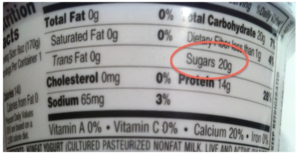Sugar is a hot topic in the nutrition industry, but with so much contradicting information, it’s hard to know what’s true and what’s not. Here are some frequently asked questions about sugar and answers that will improve your understanding and help you make healthier choices.
What is sugar?
Sugar is a simple carbohydrate that provides your body with calories to use as energy but serves no other nutritional value. This is why sweets like cookies, cakes, pastries and candy are labeled as “empty calorie” foods.
What is the difference between natural sugar and added sugar?
Natural sugar is the sugar found in whole, unprocessed foods, such as milk (lactose) and fruit (fructose). When you eat a piece of fruit, you consume natural sugar. You also consume fiber, which slows down the sugar absorption in your body, as well as other vitamins, minerals and nutrients.
Added sugars are any sugars or syrups added to foods or beverages to make products taste better, have longer shelf lives or improve textures. These are unaccompanied by nutrients.

The redesigned nutrition facts label will highlight added sugars in food. The label also will display calories per serving and serving size more prominently.
What is the national recommendation for daily sugar intake?
Did you know the average American consumes 22 teaspoons of added sugar per day? That’s more than double the national recommendation!
The American Heart Association recommends no more than six teaspoons of added sugar per day for women and no more than nine teaspoons per day for men. To put that in better perspective, a 12-ounce can of soda contains about 10 teaspoons of added sugar, which is more than your daily allowance in just one drink.
It can be difficult to keep track of your added sugar intake for two reasons. The first reason is previous nutrition labels were not required to specify the amount of natural sugar versus added sugar in a product. (Fortunately, this will become a mandatory item on all nutrition labels by July 2021.) Secondly, it can be difficult to track added sugars because nutrition labels quantify them in grams instead of teaspoons. Here is a quick sugar conversion to keep in mind to make things simpler:
1 teaspoon of sugar = 4 grams of sugar
Using this example nutrition label, which contains 20 grams of sugar, you can make a quick calculation to determine there are 5 teaspoons of sugar in this non-fat yogurt

Why is it important to limit added sugar in your diet?
Research shows consuming too much added sugar is linked to tooth decay, weight gain, higher triglyceride levels, lower high-density lipoprotein (“good cholesterol”) and heart disease. In addition to these health risks, consuming too much added sugar causes you to fill up on empty calories and skip out on more nutrient-dense options.
Is sugar addictive?
Research also shows sugar has addictive properties that leave us coming back for more. When you consume sugar, pleasure centers in the brain release feel-good chemicals, like dopamine, and give you a jolt of energy. These chemicals make it easy for us to continually repeat this cycle, craving sweets again once our “sugar high” has worn off.
What are some practical ways to lower my added sugar consumption?
The good news is there are plenty of ways to reduce your added sugar consumption without cutting out sugar completely. The first and most important way to reduce added sugar is to be aware of what you put in your body. Here are some simple choices you can make to improve your relationship with sugar going forward:
- Always read nutrition labels, and be mindful of the products you buy
- Compare products to find the option with less sugar content
- Ideally, look for items that contain less than 5g of sugar per serving and less than 5% of your daily value
- Watch out for these ingredients, which indicate added sugar:
- Anhydrous dextrose
- Brown sugar
- Confectioner’s sugar
- Corn syrup/Corn syrup solids
- Dextrose
- Fructose
- High fructose corn syrup
- Honey
- Invert sugar
- Lactose
- Malt syrup
- Maltose
- Maple syrup
- Molasses
- Nectars
- Raw sugar
- Sucrose
- Sugar
- White granulated sugar
- Follow the 80/20 rule when it comes to sweets
- Choose healthy sweets that are nutritionally dense (fruit) instead of processed sweets (cookies, cakes, ice cream) 80% of the time
- You can still indulge on other sweets, but aim to be more conscious about how often you do so
- Keep track of your added sugar consumption, and aim for less than 6 to 9 teaspoons (24-36 grams) a day
- Avoid sugar-sweetened beverages like soda, sports drinks, fruit drinks and sweetened iced teas; these beverages are the number one source of added sugars for Americans
- Be aware of foods with hidden sugar! Some examples include:
- Pasta sauce
- Yogurt
- Granola bars/Granola
- Instant oatmeal
- Salad dressings
- Cereals
- Packaged fruits/Fruit cups/Dried fruit
- Ketchup
- Barbecue sauce
- Applesauce
- Energy drinks
- Frozen, ready-made meals
- Alcohol
- Specialty coffee drinks (Starbucks, Dunkin Donuts, Wawa)
By understanding the facts and using these tips, you can make more informed choices for your health!
By: Megan McKee

